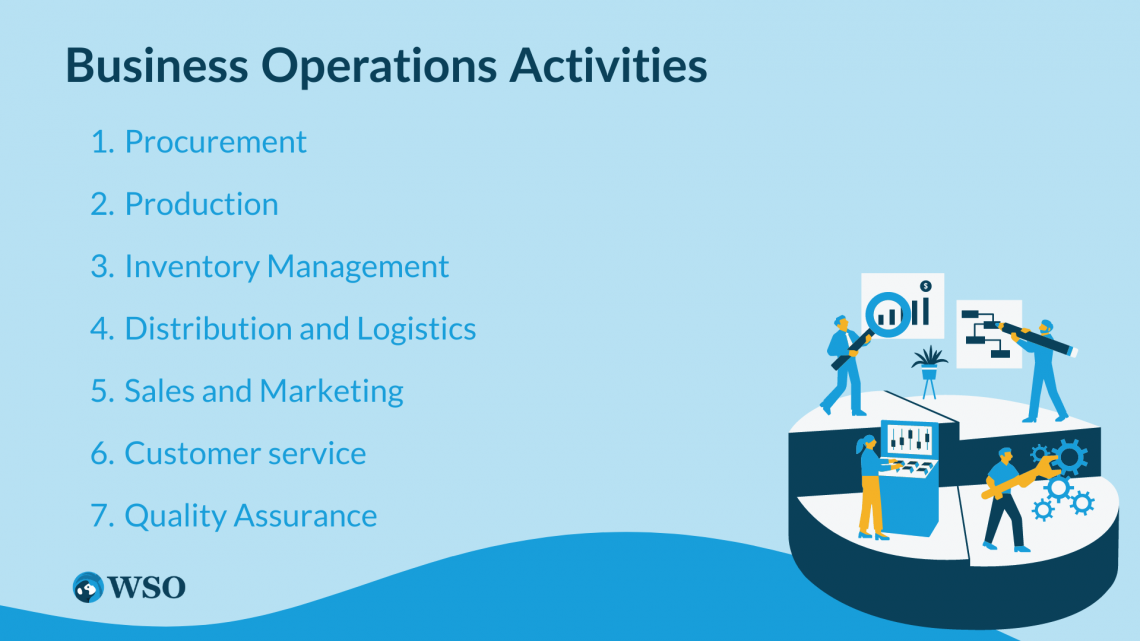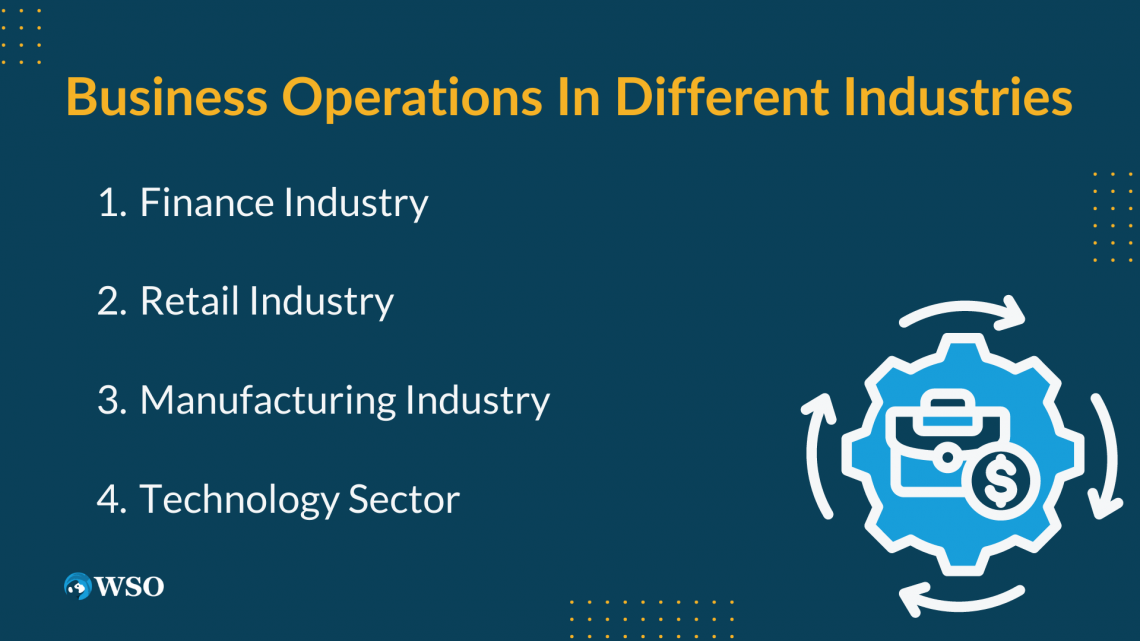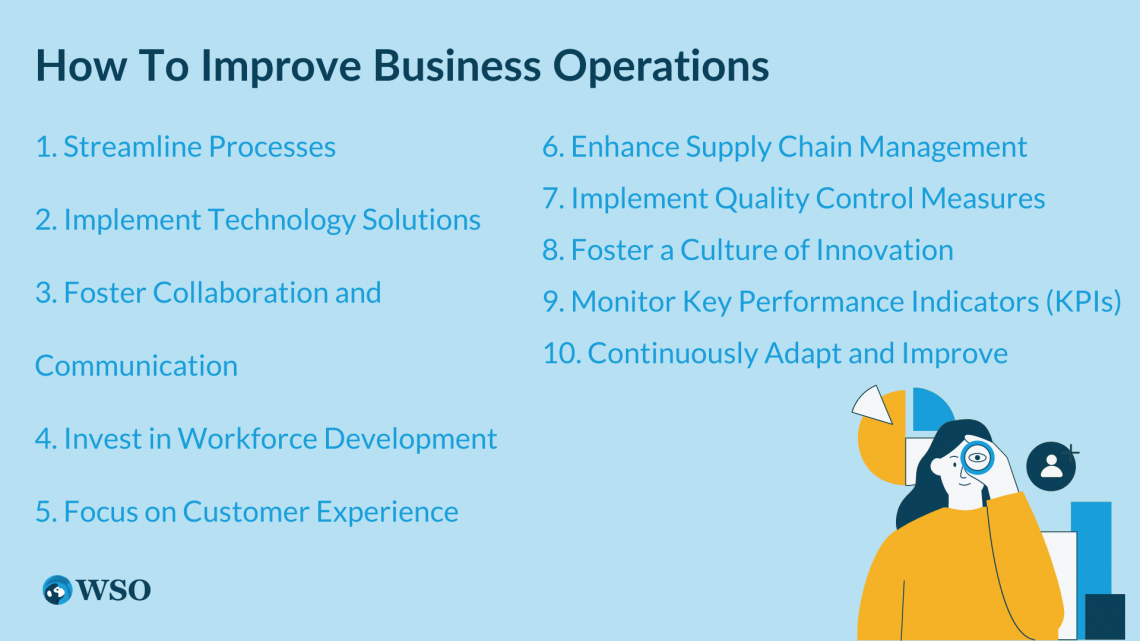Business Operations
These are organizations' actions and procedures to meet their goals and provide goods or services to clients
What are Business Operations?
Business operations are organizations' actions and procedures to meet their goals and provide goods or services to clients. These activities include a variety of jobs like buying, producing, selling, and promoting products, as well as providing customer service.

Any organization's success and sustainability depend on efficient business processes.
A few examples of factors that could have an impact on how business functions are industry, business cycle, and business life cycle. Different industries have unique operational requirements and challenges.
For example, the finance industry focuses on managing financial transactions and assessing risks, while the retail industry emphasizes sourcing products and delivering a positive customer experience.
The manufacturing industry involves transforming raw materials into finished products, and the technology industry focuses on research and development, software development, and IT services.

The business cycle, which includes expansion phases, peak, contraction, and trough, influences business operations. During economic expansion, businesses may increase procurement and production to meet growing demand.
In contrast, cost-cutting measures and efficiency improvements may be prioritized during contractions. Additionally, the business life cycle of a company impacts its operational activities.
A start-up company may focus on building infrastructure, establishing supply chains, and refining production processes, while a mature company may emphasize streamlining operations, expanding market share, and optimizing customer service.
Organizations can use several strategies to improve business operations, including:
- Streamlining processes
- Technology solutions
- Collaboration and communication
- Workforce development
- Customer experience
- Supply chain management
- Quality control measures the culture of innovation
- Key Performance Indicators (KPIs)
- Continuously adapting and improving
Key Takeaways
- Business operations are the activities and processes that organizations undertake to deliver products or services to customers and achieve their objectives.
- Finance industry operations involve banking operations, investment management, risk assessment, and financial analysis.
- Retail industry operations include sourcing products, inventory management, sales and marketing, and customer service.
- Manufacturing industry operations encompass product design, procurement, production processes, quality control, and distribution.
- Technology industry operations involve research and development, software development, hardware manufacturing, IT services, sales and marketing, and customer support.
Business Operations Activities
A company’s operating activities will vary depending on:

- Business Cycle: A company will buy more inventory when the economy expands.
- Business Life Cycle: A retail company in the start-up phase will need to spend more money on inventory management as the business grows.
- Industry: Raw materials will be part of business operations for a manufacturing firm but not for a financial institution.
Below are activities that may be included in a business’s operations. These activities can be grouped into several key areas:
1. Procurement
It involves sourcing and acquiring the necessary inputs for producing or delivering goods and services.
It includes tasks such as identifying suppliers, negotiating contracts, managing relationships with vendors, and ensuring timely materials delivery. Effective procurement practices help optimize costs, maintain quality standards, and mitigate supply chain risks.
2. Production
This refers to the process of transforming raw materials and resources into finished products or services. It includes manufacturing, assembly, packaging, and quality control activities.
Production operations aim to maximize efficiency, minimize waste, and ensure consistent product quality.
Note
Companies may implement lean manufacturing or automation techniques to streamline production processes.
3. Inventory Management
This involves overseeing inventory storage, tracking, and control. The availability of the appropriate number of products at the appropriate time to satisfy consumer demand is guaranteed by effective inventory management.
It involves tasks such as supply chain demand forecasting, monitoring stock levels, managing reordering processes, and minimizing stockouts or overstocks.
4. Distribution and Logistics
This area focuses on efficiently moving and storing goods from the production facility to the end customer. It includes activities such as warehousing, transportation, order fulfillment, and supply chain optimization.
Note
Companies can deliver goods on time, cut expenses, and keep customers happy with efficient distribution operations.
5. Sales and Marketing
These activities involve generating demand for products or services and converting leads into sales. Sales operations include tasks like lead generation, prospecting, sales negotiations, and closing deals.
Marketing operations encompass activities such as market research, branding, advertising, promotion, and customer segmentation.
6. Customer service
It assists and supports consumers before, during, and after a purchase. Customer service operations involve handling inquiries, resolving complaints, managing returns, and maintaining customer satisfaction.
Note
Building lasting relationships, encouraging client loyalty, and cultivating positive word-of-mouth all depend on providing excellent customer service.
7. Quality Assurance
This involves ensuring that products or services meet the desired quality standards. Quality assurance activities include conducting inspections, implementing quality control processes, and adhering to industry regulations and certifications.
Companies can enhance customer satisfaction, minimize returns or defects, and build a reliable reputation by maintaining high-quality standards.
Business Operations In Different Industries
A company’s operations depend on the industry in which it operates. In this section, we will discuss business operations in several industries.

1. Finance Industry
The finance industry manages financial transactions, including banking, investment, and insurance services. Giving capital to people, companies, and governments plays a crucial part in the economy.
In the finance industry, critical operations include banking operations, investment management, risk assessment, and financial analysis.
Banking operations involve activities such as accepting deposits, providing loans, processing transactions, and managing accounts. Banks also offer various financial services like credit cards, mortgages, and wealth management.
Investment management involves managing funds and portfolios to maximize client returns. This includes activities such as asset allocation, portfolio diversification, and investment research.
Note
Risk assessment is essential in the finance industry. Financial analysis is another crucial operation that involves analyzing financial statements, evaluating investment opportunities, and providing financial advice to clients.
2. Retail Industry
Businesses that offer goods and services directly to customers fall within the retail sector. It involves various operations, including sourcing products, inventory management, sales and marketing, and customer service.
Retail business can be conducted through physical stores, online portals, or both.
Sourcing products is a critical operation in the retail industry. Retailers must identify suppliers, negotiate contracts, and ensure a steady supply of merchandise. Inventory management is essential to maintain optimal stock levels, minimize costs, and prevent stockouts or overstocks.
Sales and marketing operations involve promoting products and attracting customers. This includes activities such as advertising, pricing strategies, sales promotions, and customer relationship management.
Note
Customer service is crucial for retailers to provide a positive shopping experience, handle inquiries and complaints, and build customer loyalty.
3. Manufacturing Industry
The manufacturing industry involves transforming raw materials or components into finished products. It includes operations such as product design, procurement of raw materials, production processes, quality control, and distribution.
Product design is critical in manufacturing. It involves conceptualizing and creating product specifications, considering factors like functionality, aesthetics, and manufacturability.
Obtaining raw materials, negotiating with vendors, and controlling the supply chain are all aspects of procurement.
Production processes include activities like assembly, machining, or chemical reactions, depending on the industry. Quality control ensures products meet predefined standards through inspections, testing, and process improvements.
Note
Distribution operations involve managing the logistics and transportation of finished goods to wholesalers, retailers, or end customers.
4. Technology Sector
The creation and use of cutting-edge products and services define the technology sector. It covers pursuits like software development, hardware manufacturing, IT services, and R&D.
Research and development (R&D) activities include experimenting with new technologies, building prototypes, and exploring new fields of study. R&D is crucial for innovation and staying competitive in the technology industry.
Software development includes designing, coding, and testing software applications or systems to address specific needs or provide solutions.
Hardware manufacturing involves producing computer systems, electronic devices, or components. This includes processes like designing circuits, assembly, and quality control.
IT services operations include system integration, network management, cybersecurity, and technical support.
Note
The technology industry also involves sales and marketing operations to promote and sell products or services. This may include online marketing, partnerships, and distribution channels tailored to the technology sector.
How To Improve Business Operations
Organizations must improve business operations to enhance efficiency, productivity, and profitability.

Here are several strategies to improve business operations:
1. Streamline Processes
Identify and eliminate redundant or unnecessary steps in your processes. Streamlining processes can reduce costs, minimize errors, and improve overall efficiency. Use workflow automation tools and lean principles to optimize operations.
2. Implement Technology Solutions
Embrace technology to automate manual tasks, enhance communication, and improve data management. Implementing project management tools, CRM software, and enterprise resource planning (ERP) systems can improve productivity and streamline processes.
3. Foster Collaboration and Communication
Encourage open communication and collaboration among teams. This can be achieved through regular meetings, effective internal communication tools, and project management platforms.
Note
Collaboration enhances efficiency, reduces errors, and promotes innovation.
4. Invest in Workforce Development
Provide training and development opportunities for employees to enhance their skills and knowledge. This can improve overall productivity, employee satisfaction, and performance. Encourage a culture of continuous learning and provide opportunities for career advancement.
5. Focus on Customer Experience
Prioritize delivering exceptional customer experiences. You must tailor your products according to your customer’s needs and expectations. Implement customer feedback mechanisms, analyze data, and continuously improve your offerings to meet customer demands.
6. Enhance Supply Chain Management
Improve supplier coordination, optimize inventory management, and enhance logistics operations.
Note
Streamline the supply chain by adopting technologies like vendor-managed inventory systems, demand forecasting tools, and real-time tracking solutions.
7. Implement Quality Control Measures
Develop and implement quality control processes to ensure that products or services meet or exceed customer expectations. Implement quality management systems, conduct regular inspections, and establish performance metrics to improve quality continuously.
8. Foster a Culture of Innovation
Encourage employees to think creatively and contribute innovative ideas. Foster an environment that supports experimentation, risk-taking, and learning from failures.
Note
Implement idea generation and evaluation mechanisms like suggestion boxes or innovation workshops.
9. Monitor Key Performance Indicators (KPIs)
Identify relevant KPIs for your business operations and regularly monitor them. KPIs can include metrics related to productivity, customer satisfaction, cost efficiency, and revenue generation. Use these metrics to identify areas for improvement and make data-driven decisions.
10. Continuously Adapt and Improve
Embrace a mindset of continuous improvement. Regularly assess your operations, identify bottlenecks or areas for enhancement, and implement strategies to address them. Embrace change and adapt to evolving market trends and technologies.
Conclusion
Effective business processes are crucial for organizations to remain competitive, fulfill consumer expectations, and experience sustained growth.

Businesses can enhance efficiency, productivity, and profitability by optimizing processes, leveraging technology, and prioritizing customer satisfaction. Companies often adopt various strategies and tools to manage business operations effectively.
This may include:
- Implementing enterprise resource planning (ERP) systems to integrate and streamline processes
- Utilizing data analytics for informed decision-making
- Employing project management methodologies to drive efficiency
- Embracing continuous improvement practices to optimize operations over time
Business operations cover various tasks critical to an organization's overall performance and long-term viability.
Note
Organizations can fulfill consumer requests, promote revenue growth, and keep a competitive advantage in the market by managing procurement, production, inventory, distribution, sales, advertising and marketing, customer service, and quality assurance.
Business operations in different industries have distinct characteristics and requirements. Understanding these operations is crucial for companies to effectively manage their activities, optimize processes, and provide value to their customers in each industry.
It takes commitment, cooperation, and a desire for excellence to improve corporate operations continuously. By implementing these concepts, organizations may optimize their operations, promote growth, and maintain competitiveness in today's dynamic business environment.




or Want to Sign up with your social account?